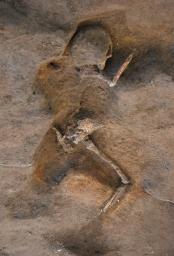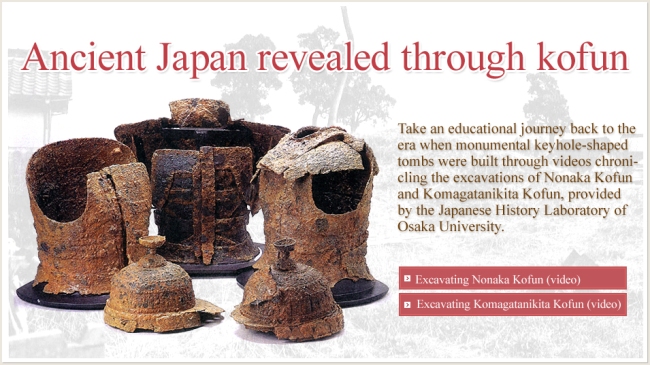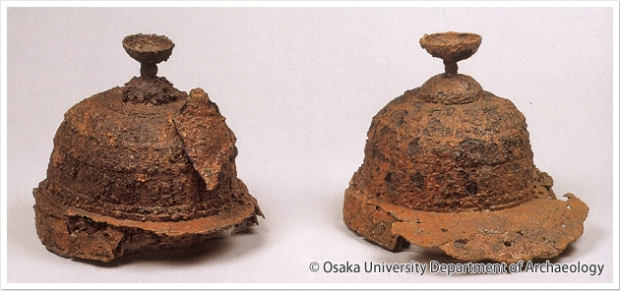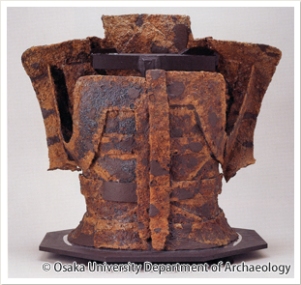More news from the Kanai Higashiura site in Shibukawa city, Gunma prefecture, where the remains of a Kofun-period man were found wearing a suit of armor.
The Kanai Higashiura site was buried following the eruption of Harunayama Futatsudake (榛名山二ッ岳; Hr-FA) in the early-6th century (it would erupt again in the mid-6th century). Nearby sites Kuroimine (黒井峯遺跡) and Nakasuji (中筋遺跡) were also affected, their levels of preservation prompting researchers to call them “the Pompeii of Japan.”
It was announced on December 10 that the remains of a Kofun-Period infant and adult male were recovered from the Kanai Higashiura site (金井東裏遺跡; Shibukawa city, Gunma prefecture), buried under a layer of volcanic ash dating to the early-6th century (the Late Kofun Period). The male was found wearing a suit of lamellar armor.

Nearest the man is the armor-wearing individual. To the left is separate piece of armor (originally thought to have been just a piece of the armor on the right). Above the armor and behind the researcher is the skull of an infant.
It was announced on April 23 that the piece of armor in the lower left of the above picture is indeed a separate suite of armor and not a disconnected piece of the suite on the right. This additional suit of lamellar armor (小札甲 or 挂甲) was found approximately one meter from the human remains, and between them around a dozen iron arrowheads were scattered. Considering the position of the second suite of armor, it would appear that the armor-clad individual had been carrying it.
Judging by the length of the femur (43.3 centimeters), researchers reconstructed a height of some 163 centimeters for the armor-wearing individual, which is believed to have been average for contemporary adult males.
The armor-clad man was found with bent knees and flexed toes. Researchers are getting closer to reconstructing the exact position he was kneeling forward in.
Additionally, approximately 100 meters south of the human remains, over 20 footprints of various sizes were discovered dating to the same period. The footprints, which clearly show the outline of the toes, were made by barefoot individuals. The larger of the footprints measures approximately 23 centimeters long. Analysis of the prints suggests that individuals continued to walk around the area even after the volcanic ash began to accumulate. For a picture of one of the footprints, please see this link.
—
Source
金井東裏遺跡:二つ目のよろいを発掘 大小20以上の足跡も−−渋川 /群馬 毎日新聞 2013年04月24日
地方版 県教委などは23日、古墳時代後期のよろいを着た人骨が全国で初めて見つかった渋川市の金井東裏遺跡で、二つ目のよろいを発掘したと発表した。いずれも6世紀初頭の火山灰の地層から見つかり、近くの榛名山二ツ岳の噴火で火砕流に巻き込まれたとみられる。また、人骨から約100メートル南にある同時期の地層からは、人の足跡が大小20以上見つかり、関連を調べる。 県教委によると、二つ目のよろいは、人骨から約1メートルの距離で掘り出され、よろいと人骨の間には鉄製の矢じりが十数点落ちていた。よろいは二つとも、長方形の鉄板を革ひもでくみ上げた「小札甲(こざねよろい)」で、県内では支配者層の古墳から出土している。 二つ目のよろいをCTスキャンすると、小さな鉄板をひもでとじた構造が確認されたほか、コンパクトに小さく丸まっていることが分かった。県教委は「人骨の主が、持って逃げようとした可能性もある」と推察している。 よろいを着た人骨についても詳細に調べたところ、大腿(だいたい)骨の長さが約43センチと確認され、身長を約163センチと推定。当時の成人男性の身長としては、標準的という。人骨は膝を折った状態で見つかったが、両足はつま先立ちのような姿勢だったことも分かった。 今月15日に見つかった足跡は、いずれも裸足で、足の指の形がくっきりと残され、大きいもので約23センチあった。榛名山二ツ岳の火山灰が降り積もった後の地層にあり、県教委は「噴火が始まってからも、周囲を人が歩いていたとみられ、興味深い」と話している。 今後、よろいを着た人骨のCTスキャンや、近くで見つかった別の人骨の分析を進めるという。【奥山はるな】
–
Source
よろい着た人骨 1メートル63 県埋蔵文化財調査事業団と県教委は23日、県庁で記者会見し、渋川市の金井東裏遺跡で昨年11月に見つかった甲(よろい)を着た人骨の身長が1メートル63と推定されると発表した。 人骨は、同事業団が調査センターに運び込んで調査。股(こ)関節から、ひざまでの骨の長さは43.3センチで、これを元に身長を計算した。 さらに人骨近くから見つかっていた甲が、人骨が着ていた一部ではなく、別の甲だったと判明。巻かれた状態で埋まっていたため、持ち運ばれていた可能性があるという。人骨から100メートルほど離れた場所には裸足の足跡が20個以上も見つかった。 甲を着た人骨は今後、甲内部の調査や頭部のコンピューター断層撮影法(CT)調査を実施するという。 (2013年4月24日 読売新聞)




